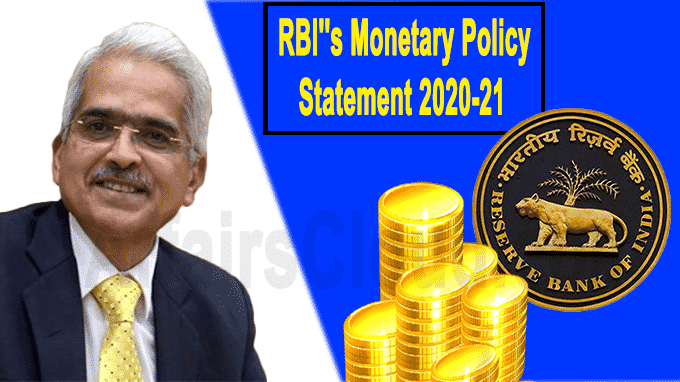 On May 22, 2020, The Reserve Bank of India (RBI) has released its Monetary Policy Statement 2020-21 in Mumbai , Maharashtra. The three-day (May 20 to 22,2020) Monetary Policy Committee (MPC) virtual meeting by the 6 members was headed by RBI Governor Shaktikanta Das with the members Dr. Pami Dua, Dr. Ravindra H. Dholakia, Dr. Janak Raj, Dr. Michael Debabrata Patra and Dr. Chetan Ghate.
On May 22, 2020, The Reserve Bank of India (RBI) has released its Monetary Policy Statement 2020-21 in Mumbai , Maharashtra. The three-day (May 20 to 22,2020) Monetary Policy Committee (MPC) virtual meeting by the 6 members was headed by RBI Governor Shaktikanta Das with the members Dr. Pami Dua, Dr. Ravindra H. Dholakia, Dr. Janak Raj, Dr. Michael Debabrata Patra and Dr. Chetan Ghate.
The minutes of the MPC’s meeting will be published by June 5, 2020.
Highlights of the meet:
i.All members of the MPC unanimously voted to reduce the policy repo rate under the liquidity adjustment facility (LAF) to 4.0 % to continue with the accommodative stance as long as it is necessary to revive growth and mitigate the impact of coronavirus (COVID-19 on the economy.
ii.These decisions are in line with the aim of achieving the medium-term target for consumer price index (CPI) inflation of 4 % while supporting growth.
Following table showing the policy rate changed in the meeting:
| Policy rate | New Rate | Previous Rate | Change in Basis points (bps) |
| Policy Repo Rate | 4.0% | 4.40 % | 40 |
| Reverse Repo Rate | 3.35% | 3.75% | 40 |
| Marginal Standing Facility Rate | 4.25% | 4.65% | 40 |
| Bank Rate | 4.25% | 4.65% | 40 |
| Cash reserve Ratio (CRR) | 3% | 3% | No change |
| Statutory Liquidity Ratio (SLR) | 18.00% | 18.25% | 25 |
RBI extends moratorium on loans for another 3 months till August 2020
In order to provide relief for those paying EMI (Equated Monthly Installment) of term loan, the RBI has extended the moratorium period for the repayment of loans by three months, i.e. August 31, 2020, which make it a total of 6 months moratorium on loan EMIs starting from March 1, 2020.
The earlier three-month moratorium on the loan EMIs was ending on May 31, 2020.
i.The RBI taken this decision asthe flow of people’s income has not been smooth again due to the continuation of the lockdown due to coronavirus (COVID-19).
What is Moratorium? Moratorium is the period during which one do not have to pay EMI on the loan taken. This period is also known as EMI holiday. Such breaks are usually offered to help individuals experiencing temporary financial difficulties recover from it.
India’s 2020-21 GDP growth rate expected to be negative: RBI Governor
According to the RBI Governor Shaktikanta Das, India’s gross domestic product (GDP) growth will be in negative territory in 2020-21 as the outbreak of coronavirus has disrupted economic activities. He also stated inflation outlook is “highly uncertain”.
Reserve Bank infuses Rs 15,000-crore line of credit to EXIM Bank
The Reserve Bank extended loan of Rs 15,000 crore to the Export-Import Bank of India (EXIM Bank), which will be given this loan for 90 days to swap US (United States) dollars.This will help deal with the economic challenges faced by Coronavirus.
i.Export-import trade of India has severely damaged because of external demand crippling owing to the pandemic and decline in import of essential goods and services.
RBI increases export credit period to 15 months from 12 months
As India’s exports and imports getting impacted by the pandemic, the RBI hiked the export credit time sanctioned by banks from 12 months to15 months.
i.It has also increased the time interval for completion of outward remittances against normal imports (excluding import of gold/diamonds and precious stones/jewellery) into India to 12 months from 6 months from the date of shipment.
Reserve bank grants Rs 15,000-crore refinance facility for SIDBI
In a bid to provide greater flexibility to SIDBI (Small Industries Development Bank of India) in its operations, the RBI has announced a special refinance facility of Rs 15,000 crore to SIDBI for on-lending/refinancing to MSMEs (Micro, Small and Medium Enterprises). Now SIDBI will get an additional 90 days to use the amount.
RBI eases CSF withdrawal rules ; arranges additional Rs 13,300 crore for states
The Reserve Bank has relaxed the withdrawal rules from the Consolidated Sinking Fund (CSF) to provide more resources to the states. With this, now the states will be able to withdraw an additional Rs 13,300 crore from this fund to make necessary payments. This change in withdrawal rules will come into force with immediate effect and will be valid till 31 March 2021.
i. With the general permission for withdrawal and this exemption, the states will be able to complete their 45 % redemptions in the financial year 2020-21.
ii.In view of the corona virus epidemic and weak financial condition of the state governments, the RBI has reviewed the scheme and decided to relax the rules governing withdrawal from CSF, which will help the states to repay large portion of market loans in the current financial year (FY 21).
Industrial production decrease by 17 % in March with manufacturing activity down by 21 % : RBI
According to the RBI Governor Shaktikanta Das, there has been a 17 % decrease in industrial production in March 2020 with the output of 8 core industries (coal, crude oil, natural gas, refinery products, fertiliser, steel, cement and electricity) has decreased by 6.5 % and manufacturing has fallen by 21 %.
Static Points:
- Repo Rate: It is the rate at which RBI lends money to commercial banks.
- Reverse Repo rate: It is the rate at which RBI borrows money from commercial banks. Cash Reserve Ratio (CRR): The share of net demand and time liabilities (deposits) that banks must maintain a cash balance with the RBI.
- Statutory Liquidity Ratio (SLR): The share of net demand and time liabilities (deposits) that banks must maintain in safe and liquid assets, such as government securities, cash, and gold.
- Bank Rate: It is the rate at which the RBI is ready to buy or rediscount bills of exchange or other commercial papers for the long term.
- Marginal Standing Facility Rate (MSF): The rate at which the scheduled banks can borrow funds from the RBI overnight, against the approved government securities is termed as MSF.
About Reserve Bank of India (RBI):
Headquarters– Mumbai, Maharashtra
Formation– 1 April 1935
Deputy Governors– 4 (Bibhu Prasad Kanungo, Mahesh Kumar Jain, Michael Debabrata Patra, one is yet to be appointed)




